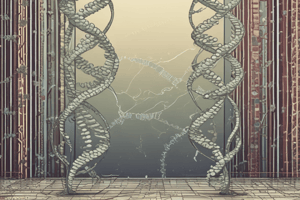Podcast
Questions and Answers
What is the purpose of the primer in the Sanger method of sequence analysis?
What is the purpose of the primer in the Sanger method of sequence analysis?
The primer is designed to bind to the target DNA sequence and is labeled with a radioactive or fluorescent marker.
What is the function of dideoxynucleotides in the Sanger method?
What is the function of dideoxynucleotides in the Sanger method?
Dideoxynucleotides are incorporated randomly into the growing DNA strand, terminating synthesis at specific points.
What is the purpose of gel electrophoresis in the Sanger method?
What is the purpose of gel electrophoresis in the Sanger method?
Gel electrophoresis is used to separate the reaction products by size, allowing the shorter strands to migrate faster than the longer ones.
How is the sequence of the DNA determined in the Sanger method?
How is the sequence of the DNA determined in the Sanger method?
What is the advantage of the Sanger method in terms of DNA fragment size?
What is the advantage of the Sanger method in terms of DNA fragment size?
What is one limitation of the Sanger method?
What is one limitation of the Sanger method?
Flashcards are hidden until you start studying
Study Notes
Sanger Method: Sequence Analysis
Principle: The Sanger method, also known as dideoxy sequencing, is a laboratory technique used to determine the order of nucleotide bases in a DNA molecule. It is based on the principle of enzymatic synthesis of DNA strands, which are terminated by the incorporation of dideoxynucleotides.
Sequence Analysis:
Step 1: Template Preparation
- The target DNA is amplified and prepared for sequencing
- The DNA is denatured to create single-stranded templates
Step 2: Primer Design
- A primer is designed to bind to the target DNA sequence
- The primer is labeled with a radioactive or fluorescent marker
Step 3: Sequencing Reaction
- The template, primer, and dideoxynucleotides are mixed with DNA polymerase
- The reaction is carried out in four separate tubes, each containing a different dideoxynucleotide (ddATP, ddCTP, ddGTP, and ddTTP)
- The dideoxynucleotides are incorporated randomly into the growing DNA strand, terminating synthesis at specific points
Step 4: Gel Electrophoresis
- The reaction products are separated by size using gel electrophoresis
- The gel is run in a specific direction, allowing the shorter strands to migrate faster than the longer ones
Step 5: Autoradiography
- The gel is exposed to X-ray film or a phosphorimager to detect the radioactive or fluorescent labels
- The resulting autoradiogram shows a series of bands, each representing a different DNA sequence
Step 6: Sequence Determination
- The sequence of the DNA is determined by reading the autoradiogram from bottom to top
- The sequence is written in the 5' to 3' direction
- The dideoxynucleotides are used to determine the sequence of the DNA by identifying the termination points
Advantages:
- High accuracy and efficiency
- Can be used to sequence large DNA fragments
- Relatively fast and inexpensive compared to other sequencing methods
Limitations:
- Limited to sequencing DNA fragments up to 1 kb in length
- Requires a significant amount of DNA template
- Can be affected by the quality of the DNA template and primers
Sanger Method: Sequence Analysis
- The Sanger method, also known as dideoxy sequencing, is a laboratory technique used to determine the order of nucleotide bases in a DNA molecule
- The method is based on the principle of enzymatic synthesis of DNA strands, which are terminated by the incorporation of dideoxynucleotides
Template Preparation
- The target DNA is amplified and prepared for sequencing
- The DNA is denatured to create single-stranded templates
Primer Design
- A primer is designed to bind to the target DNA sequence
- The primer is labeled with a radioactive or fluorescent marker
Sequencing Reaction
- The template, primer, and dideoxynucleotides are mixed with DNA polymerase
- The reaction is carried out in four separate tubes, each containing a different dideoxynucleotide (ddATP, ddCTP, ddGTP, and ddTTP)
- The dideoxynucleotides are incorporated randomly into the growing DNA strand, terminating synthesis at specific points
Gel Electrophoresis
- The reaction products are separated by size using gel electrophoresis
- The gel is run in a specific direction, allowing the shorter strands to migrate faster than the longer ones
Autoradiography
- The gel is exposed to X-ray film or a phosphorimager to detect the radioactive or fluorescent labels
- The resulting autoradiogram shows a series of bands, each representing a different DNA sequence
Sequence Determination
- The sequence of the DNA is determined by reading the autoradiogram from bottom to top
- The sequence is written in the 5' to 3' direction
- The dideoxynucleotides are used to determine the sequence of the DNA by identifying the termination points
Advantages
- The Sanger method is highly accurate and efficient
- It can be used to sequence large DNA fragments
- The method is relatively fast and inexpensive compared to other sequencing methods
Limitations
- The Sanger method is limited to sequencing DNA fragments up to 1 kb in length
- It requires a significant amount of DNA template
- The method can be affected by the quality of the DNA template and primers
Studying That Suits You
Use AI to generate personalized quizzes and flashcards to suit your learning preferences.




